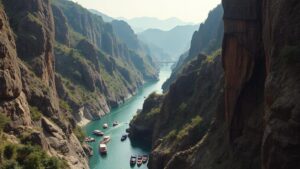Following accounts of the lost capital of the Chachapoya, the “Warriors of the Clouds.”
The Lost Capital of the Chachapoya: Discovering the Warriors of the Clouds
The Chachapoya civilization, often referred to as the Warriors of the Clouds, thrived in the Andean highlands of Peru from approximately 900 AD to 1470 AD. Occupying a region characterized by rugged mountains and cloud forests, these people developed a unique culture that remains shrouded in mystery to this day. Little is known about the exact location of their capital, but there are compelling accounts and archaeological evidence pointing to a significant city that may hold the key to understanding this fascinating civilization.
Geographical Context of the Chachapoya
The Chachapoya lived in an area known for its steep slopes and high-altitude cloud forests, primarily in the region of what is now the Amazonas department in northern Peru. This challenging terrain was not only a natural barrier but also a strategic advantage that offered protection against invaders, particularly during the expansion of the Inca Empire.
- Located between the Marañón and Huallaga rivers
- Altitude ranges from 2,000 to 3,000 meters above sea level
- Home to stunning archaeological sites, such as Kuelap and Revash
Archaeological Insights Into the Chachapoya Capital
While the precise capital of the Chachapoya civilization has not been definitively identified, several archaeological sites provide vital clues. Kuelap, often referred to as the Machu Picchu of the North, stands out due to its impressive stone structures and fortified walls, suggesting it was a significant urban center in its time.
- Kuelap features over 400 circular stone buildings
- The site was strategically situated on a hilltop, enhancing defense capabilities
- Evidence of agriculture in the surrounding valley indicates a complex economy
Discoveries made at Kuelap, such as ceremonial artifacts and intricate wall carvings, have provided insights into the spiritual practices and social structure of the Chachapoya. For example, many tombs uncovered within the site have yielded mummies, demonstrating their sophisticated burial customs.
The Invasion and Its Impact
The Chachapoya civilization faced significant upheaval during the Inca conquest in the late 15th century. Historians believe that this invasion led to the decline of their political structure and the potential relocation of their center of power. After the fall of their capital, many Chachapoya fled into the depths of the cloud forests, preserving aspects of their culture even as they became assimilated into the broader Inca Empire.
One notorious account is that of the Spanish conquistador, Francisco Pizarro, who described the Chachapoya as fierce warriors. Plus, historical texts indicate that the Chachapoya successfully resisted the Incas for several years, which showcases their resilience and adaptability.
Modern Exploration and Continued Research
In recent years, archaeologists and historians have rekindled interest in the Chachapoya civilization, utilizing modern technology to explore remains of their settlements. For example, satellite imagery and LiDAR (Light Detection and Ranging) technology have revealed previously undetected structures hidden under thick vegetation in the Amazon, suggesting a much larger population than previously thought.
Conclusion: The Enduring Legacy of the Chachapoya
While the exact location of the lost capital of the Chachapoya remains elusive, the ongoing research into their civilization illuminates the remarkable achievements of a people who adapted to and thrived in one of the most challenging environments on Earth. Their fortresses, cultural practices, and untold stories continue to inspire intrigue among archaeologists and the public alike.
As more discoveries emerge, the legacy of the Warriors of the Clouds serves as a profound reminder of the complexities of Andean history. As we unravel the secrets of the past, we gain not only knowledge of a civilization long thought lost but also a deeper appreciation of cultural resilience and adaptation.
For those interested in exploring this topic further, consider visiting archaeological sites such as Kuelap and attending guided tours that delve into the rich history and legacy of the Chachapoya.



